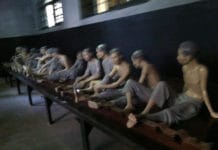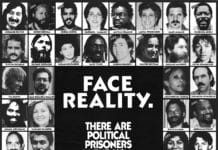by Ahjamu Baruti
Note from a supporter: The article was written by a conscious-minded political prisoner and former inmate of Kinross Correctional during all the events described in “Michigan prisoners rise up,” published in the November Bay View. Ahjamu was strip searched, cuffed, locked in leg irons and shipped to Oaks Correctional in Manistee Michigan and thrown in a cell in Administrative Segregation, where he stays 23 hours a day since the events unfolded at Kinross.

The psychological warfare that is taking place in the prisons here in the United Snakes of Amerikkka is placing prisoners in the soul breaker (segregation) for confinement that equals decades.
I refer to segregation being the soul breaker because that is what long term segregation is designed to do, break a man’s soul completely. Among the misconceptions about solitary confinement is that it’s used only for a few weeks or months.
An estimated 80,000 Amerikan prisoners, many with no record of violence, are confined to a cell 23 hours a day in a cell about the size of two queen sized mattresses, with a single hour in an exercise cage that is similar to a dog’s cage. Some prisoners who are confined to segregation are not allowed visits or phone calls. Some prisoners have no TV or radio. Some prisoners never lay eyes on each other, and some go years without fresh air and sunlight.
After nearly 44 years in solitary confinement, Albert Woodfox of the Angola 3 was freed from Angola Prison on his 69th birthday. Woodfox was the longest serving solitary confinement prisoner to be freed from prison after four decades. He had been in prison for 45 years, nearly 44 of them in solitary confinement.
Hugo (Yogi) Lyon Pinell, a political prisoner with the San Quentin 6, was also condemned to solitary confinement for over four decades, nearly 46 years. He and Albert Woodfox did more time in solitary confinement than any prisoners in United States history.
Political prisoner Russell Maroon Shoatz had spent 22 years in solitary confinement in the Pennsylvania Department of Corrections, from 1983 to Feb. 20, 2014, when he was released to general population.
I refer to segregation being the soul breaker because that is what long term segregation is designed to do, break a man’s soul completely.
Solitary confinement started in the United States as a morally progressive social experiment in the 1820s. Quakers wanted lawmakers to replace mutilations, amputations and the death penalty with rehabilitation. The hope was that long periods of introspection would help criminals repent.
After British author Charles Dickens (1812-1870) toured a Pennsylvania prison in the 1840s, he described prolonged isolation as a slow and daily tampering with the mystery of the brain, immeasurably worse than any torture of the body.
Some of his contemporaries shared that same view about long term segregation. Alexis De Tocqueville (1805-1859), a French statesman and author, reported from a prison in New York in the 1820s that it does not reform, it kills!
Most prisons suspended the practice of long term segregation in the mid- to late 1800s, once it became clear the theory did not work. The U.S. Supreme Court punctuated that point in 1890, when it freed a Colorado man, recognizing the psychological harm isolation had caused him.

Solitary confinement was largely unused for about a century, until October 1983, when, in separate incidents, prisoners killed two guards in one day at the U.S. Penitentiary in Marion, Illinois. The prison went into lockdown for the next 23 years, setting the model for dozens of state and federal supermax prisons, designed specifically for mass isolation.
Long term solitary confinement is cruel and unusual punishment, due to the deprivation of basic human needs such as environmental stimulation and social interaction.
For prison and staff safety, I am totally in agreement with short periods of confinement for the most violent prisoners. Solitary confinement is psychological warfare, because once a person is confined to segregation, it’s about how to deal with his own mind.
Being isolated for a long period of time can drive one insane. To utilize their time, some prisoners in segregation will begin to pace their cells like a caged animal at a zoo. Some will pass their time by praying and meditating or talking to themselves, while others will read voraciously.
Defiance can kill time in solitary. Some prisoners will kick walls or bang their cups against their doors. Some flood their cell by clogging their toilets with toilet paper, and some even break light bulbs and set their mattresses on fire!
Long term solitary confinement is cruel and unusual punishment, due to the deprivation of basic human needs such as environmental stimulation and social interaction.
The psychological effects of long term confinement on the human brain are phenomenal, because the human brain needs social contact like our lungs need air!
Zoo animals are being honored with fulfillment of these needs. The cruelty of caging them for long periods of time alone or in tight spaces is acknowledged. Federal guidelines for laboratory animals require more space be provided for them, along with sensory stimulation and environmental enrichment, than what is afforded prisoners in solitary confinement.
I believe anyone who spends more than three years confined in solitary confinement will have some type of psychological effects – anti-social behavior – for the rest of their lives. In 2006, a bipartisan national task force convened by the Vera Institute for Justice called for ending long term solitary confinement. A report by the Commission on Safety and Abuse in American prisons cited studies showing that solitary confinement impairs brain functioning and causes psychosis and serious depression.
The psychological effects of long term confinement on the human brain are phenomenal, because the human brain needs social contact like our lungs need air!
Prison guards have attempted to use the argument that prisoners shouting to each other between cell blocks, across exercise cages and down drainpipes constitutes meaningful forms of social interaction during their confinement in long-term segregation. Such communication will never replace the basic need for social interaction with another human being and the heightening of one’s senses with the touch and sight of another human being.

Babies are aware of the importance of the sense of touch in their social interaction with their mother; without it, they would suffer psychological trauma. When babies become aware that they are loved, it heightens other senses in them.
People in the free world, through their socialization with each other in society, come to know who they are by interacting with each other.
Amerika leads the world in placing prisoners in solitary confinement. Sen. John McCain spent two years in solitary as a POW in Vietnam. He stated, “It crushes your spirit and weakens your resistance more effectively than any other form of mistreatment.”
Amerika leads the world in placing prisoners in solitary confinement.
Craig Haney, a psychologist and professor at the University of California in Santa Cruz, has spent his career studying mental health effects of solitary confinement. He describes the effects of long-term solitary confinement, including psychosis, self-mutilation and suicide.
The problem is that most of the psychological damage done to prisoners in solitary confinement occurs invisibly in silence and stillness. The effects may not become fully apparent until the prisoner re-enters society; then society has a responsibility to address it promptly.
Send our brother some love and light: Ahjamu Baruti, 178539, Oaks Correctional Facility, 1500 Caberfee Hwy, Manistee, MI 49660.

 Store
Store












